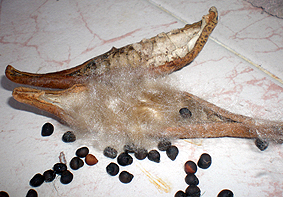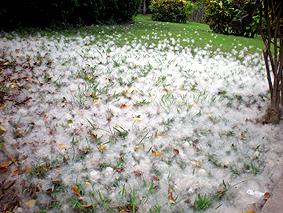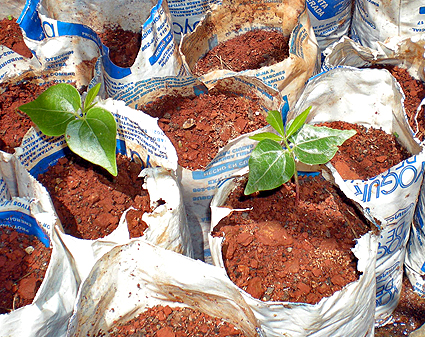If You Want to Plant a Ceiba Tree
Isbel Diaz Torres

I sowed Ceiba tree seeds for the first time, and now they’ve sprouted. The procedure is very simple, so I wanted to share it with you, the readers.
This summer presented a special opportunity in Cuba for those who want to have their own Ceiba plant. I don’t know if you’re aware that this tree blossoms only every four years, and that 2010 was one of those chances. Therefore, those who aren’t able to get ahold of its seeds this season will have to wait until 2014.
The seeds of the ceiba are very conspicuous, because each one of the thousands of seeds produced by the tree generates very fine and clear “hairs” that form a very light cotton like ball. This is the mechanism developed by that species to disseminate its seeds great distances by benefiting from the force of the wind.

This is why when a Ceiba has blossomed and produced fruits and seeds, it can be detected from far away. When the time comes, it looks as if it had snowed all around because the “cotton” of the seeds covers everything. Inside that “wool” are seeds that are tiny, round, dark brown and hard.
My recommendation is to collect as many seeds as possible. Around the Almendares Bridge in Havana I collected some 1,400 seeds from a single ceiba this June. This didn’t take me more than 30 minutes. The extra ones can be given to people who want to plant them.
Stripped of the cotton, they should be placed in a container of water and left there for three days. Although some people suggested to me changing the water up to two times a day, my experience was that the least you move the recipient, placed in a dark spot, the better is the chance for later germination.

After three days you should prepare several plastic bags with soil and place one of two seeds in each bag.
For a good result it’s advisable not to press the seed into the soil, but only to make a hole in the soil just over an inch deep with your finger, drop the seeds in and cover them with earth.
Place the seeds in a sunny place, water them daily and the seedling should appear in less than three days – at least this is what happened with my sprouts.
I felt like a blissful father when I saw my little ceibas reaching toward the sky.

I can post you hundreds of seeds. Not seedlings. From west africa
Would they grow in the low desert of AZ?
Do you have any seeds left?
Only two of six seeds sprouted. I don’t think I left them in water for three days, maybe only one or two.
OLI I don’t know what will happen, but I have two sprouts here in Accokeek MD. I plan to keep them in pots until spring, then put them in the ground. Far from the house.
C W Bonsai
Hey, thanks for the recommendations!!! .
I’m giving it a try as bonsai from seed. I repotted them as sprouts after they grew the first set of non seedling leaves (around the 6 week mark after they sprouted) with no problems. They had one very small tap root and took it quite well.
After about 1 year as they were quite healthy and growing I repotted again. However, the repotting trauma to their more complex roots seems to have made the poor things very very sad.
I noticed that they had a lot of very very tiny roots, but not much in the way of a substantial tap root structure. (which was a new one to me, they are about 10in high but only 2-3in of real roots.)
So, if doing the bonsai route, it may be best to wait till they are at least 2 or more years old before repotting once you have moved the initial sprouts . (so start in a biggish pot)
how quickly does the ceiba grow? and what min/max temperature or climate must have? Could it possibly grown in the foot hills of North GA USA….most specifically Rabun Gap, GA??>>>
isbel, i am very interested in possibly planting one of these ceiba trees here in california. after visiting guatemala and discovering them for the first time i have fallen in love with these giant trees. how can i get a hold of one of your seedlings? please reply. thank you
I’ve never seen it. Perhaps it’s possible since bonsais from Ficus sp. (jagüey, laurel, etc.) are quite common here, and those are also huge trees. Of course, the branches of the old Ceiba tree next to my building are about two meters in diameter, and the trunk is over 5m in diameter. This tree (before it was pruned to death) growed over the five floor buildings around.
Anyway, I will ask to a friend. Thanks for your comments.
?!A miniature Ceiba tree?! It would be like breeding a miniature Morgan horse! In the front yard of my house is a large Black Walnut tree. The former owners told me this story: When they adopted a young boy in 1973, he brought with him from the orphanage a little plastic pot containing a young Black Walnut, which he planted in the front yard. Now, more than a quarter century later, it is large tree providing shade for the front of our house. Also, if I ever followed the lengthy and baroque, nay rococo, process of processing these black walnuts, I could eat them, tas well!
I wonder if it is possible to do a bonsai ceiba tree?